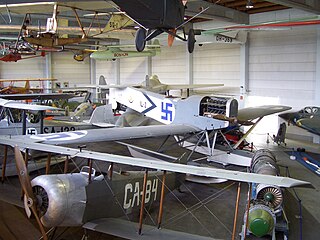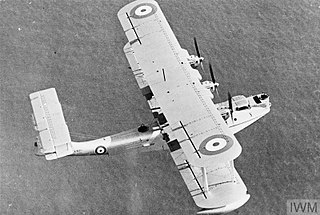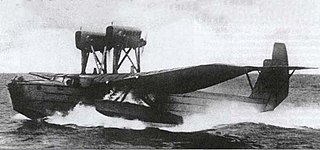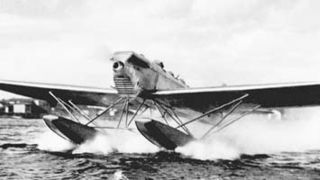Operators

| C.24 | |
|---|---|
| Role | Fighter aircraft |
| Manufacturer | IVL |
| Designer | Kurt Berger |
| First flight | April 16, 1924 |
| Primary user | Finnish Air Force |
| Number built | 1 |
IVL C.24 was the first aircraft to be designed in Finland and built in an industrial environment. The aircraft was manufactured by IVL, but only in one example.
The designer of the aircraft was engineer Kurt Berger. The aircraft made its maiden flight on April 16, 1924, piloted by Georg Jäderholm.
The aircraft was a one seated, high-wing monoplane. It was designed as a fighter, but its engine was under-powered, the speed moderate and flight characteristics poor. The visibility from the pilot's seat was also very poor. The aircraft was in Finnish Air Force use for a short time.
Data from AVI [1]
General characteristics
Performance
|crew=One, pilot |capacity= |length main=7.1 m |length alt=23 ft 3 in |span main=12.1 m |span alt= 39 ft 8 in |height main=2.9 m |height alt=9 ft 6 in |area main=19 m2 |area alt= 204.4 ft2 |airfoil= |empty weight main=660 kg |empty weight alt=1,452 lb |loaded weight main= kg |loaded weight alt= lb |useful load main= kg |useful load alt= kg |max takeoff weight main=870 kg |max takeoff weight alt= 1,740 lb
Related lists
The Tupolev Tu-75 was a military transport variant of the Tu-4 bomber, as was a similar airliner, the Tu-70, both using a new, purpose-designed fuselage. The first Soviet military machine of this class, it was equipped with a rear fuselage loading ramp. It was not placed into production because the VVS decided it would be cheaper to modify its existing Tu-4s for the transport mission and to use its existing Lisunov Li-2 and Ilyushin Il-12 transports.

The Zivko Edge 540 manufactured by Zivko Aeronautics is a highly aerobatic aircraft. Capable of a 420 degree per second roll rate and a 3,700 foot per minute climb rate, it has been flown to victory on the international Unlimited aerobatics circuit several times since the mid-1990s. A tandem-seat version is sold as the Edge 540T.

The Seversky XP-41 was a fighter aircraft built in the United States in 1939. A single prototype was modified from the last production Seversky P-35 by adding a new streamlined canopy, a Pratt & Whitney R-1830-19 engine with a two-speed supercharger, and revised landing gear. The XP-41 first flew in March 1939. The aircraft was developed in parallel with the P-43 Lancer, and work was stopped when the USAAC showed a preference for the latter.

The X-26 Frigate is the longest-lived of the X-plane programs. The program included the X-26A Frigate sailplane and the motorized X-26B Quiet Thruster versions: QT-2, QT-2PC, and QT-2PCII. All were based on the Schweizer SGS 2-32 sailplane.

The Comp Air 7 is an American piston or turboprop-powered light civil utility aircraft manufactured in kit form by Comp Air. It is configured as a conventional high-wing monoplane with tailwheel undercarriage.
The Focke-Wulf Ta 153 (GH+KV) was a prototype German fighter aircraft built during World War II. It was a development of the Fw 190C, a Fw 190A with a DB 603A engine.

IVL A.22 Hansa was a Finnish license copy of the German two-seat, low winged single-engined seaplane Hansa-Brandenburg W.33, which had been designed by Hansa und Brandenburgische Flugzeugwerke in the 1920s.

The Valmet PIK-23 Towmaster or Suhinu is a Finnish two-seato glider towing/primary trainer aircraft built entirely out of composite materials in the early 1980s.
The Airspeed AS.45 Cambridge was a British advanced trainer of the Second World War built by Airspeed Limited. It did not reach the production stage.

IVL Haukka were a series of Finnish biplane fighters designed by Kurt Berger at IVL in 1927. "Haukka" is Finnish for "Hawk".

The Blackburn Perth was a British flying boat in service during the interwar period. It was essentially an upgraded Iris, hence the largest flying-boat to serve with the Royal Air Force at the time.
The Arado W 2 was a two-seat twin-engine seaplane trainer developed for the DVS in 1928. It was a cantilever monoplane with a fabric-covered steel tube fuselage that accommodated the pilot and instructor in tandem open cockpits. The undercarriage consisted of two pontoons carried on steel struts.

The Zenith STOL CH 801 is a four-seat sport STOL aircraft developed by Chris Heintz and available in kit form from the Zenith Aircraft Company.

The ANT-8 was an experimental flying boat designed by Tupolev. It was designated the "MDR-2" by the military.

The Sikorsky S-10 was a Russian Empiren military twin-float seaplane that served with the Baltic Fleet from the summer of 1913 to 1915. After Igor Sikorsky built the successful Sikorsky S-6 for the Russian military, he tried to build another successful aircraft for them. The S-10 was a modified S-6B built by the Russo-Baltic Carriage Factory. Approximately sixteen production versions of the S-10 were built. It had a less powerful engine and generally weaker structure than the S-6. They had either an 80 HP Gnome Monosoupape or a 100 HP Argus Motoren engine. Some were deployed on the world's first operational seaplane carriers.

The ASK 16 was designed by Rudolf Kaiser for production by Alexander Schleicher GmbH & Co of Furth, Germany. The aircraft is of welded tube, wood and fabric construction and has a low-set high-aspect-ratio wing.

The EM-10 Bielik is a low cost Polish military training aircraft prototype, built by Margański & Mysłowski Zakłady Lotnicze, first flown on 4 June 2003. The single engine aircraft has a composite fuselage with a light alloy aft section and the pressurized cockpit is fitted with ejection seats.

The Bréguet XI was a prototype French biplane bomber of the First World War.
The Grigorovich MRL-1 was a long-range reconnaissance flying boat designed by the Grigorovich Design Bureau for the Soviet Navy in the mid-1920s.

The Heinkel HE 9 was a reconnaissance seaplane developed by the German aviation company Ernst Heinkel Flugzeugwerke AG in the late 1920s.
| Wikimedia Commons has media related to IVL C.24 . |